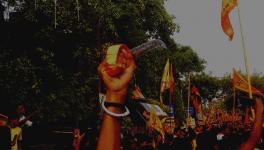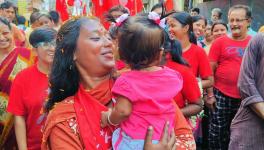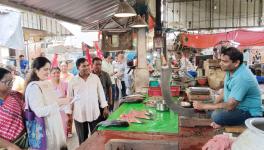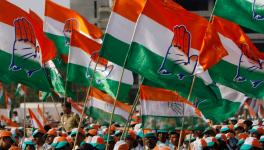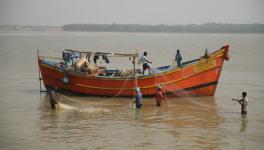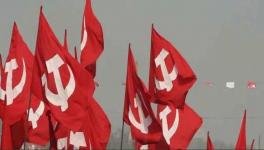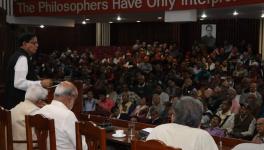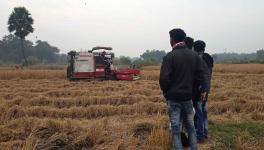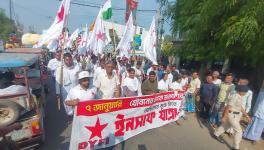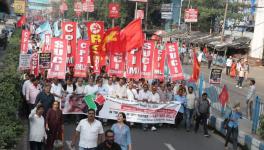BJP, TMC Fan Caste and Religious Identity Politics in West Bengal
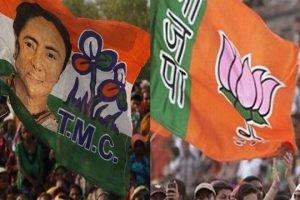
Kolkata – Horrendous memories of the communal violence that marred Bengal at the time of India’s Partition and Independence are reviving among people today as the state gears up for what could be a watershed Assembly election.
This dark past had been vanquished and buried during 34 years of Left Front rule from 1977 to 2011. Since Trinamool Congress, led by Mamata Banerjee, came to power in 2011, political violence escalated, mostly led by the ruling party’s cadres against the Left.
But, in recent months, an even more dangerous turn has taken place as the new political contender, the Bharatiya Janata Party, seeks to gain power, riding on divisive and toxic politics. BJP and TMC are playing out this game of death as they fight to create and demarcate political space amongst themselves. [See appendix for some major communal and violent incidents]
The process actually began after 2011 when BJP and the larger Sangh Parivar openly started using every opportunity to communalise politics. The RSS stepped up its activities in the state. Durga Puja, the major festival of Bengal, became an early battleground of this attempt to sow discord among communities, destroying years of amity. There were several attempts to create hostility toward the minority community by using the Durga Puja immersion schedule as occasions for heightening strife, under the pretext of the event coinciding with the Muslim solemn occasion of Muharram. This had never happened before. The ruling TMC played into the hands of communal forces further aggravating the situation.
Communal Cauldron
After the 2016 Assembly elections, which saw the return of TMC to power and a drubbing to BJP, the state witnessed several incidents of communal violence. In 2016 itself, rioting broke out in Dhulagarh and later, in the 2017, there was another such incident at Baduria in Bashirhat area of North 24 Parganas district. In 2018, a religious procession on a Hindu festival was turned into a brutal riot at Asansol, in the colliery belt of the state. This was the incident when a Maulvi famously appealed for peace even as news came that his only son, a school student, had been accosted by an armed crowd and killed.
A noted scribe, Subhajit Bagchi, had visited the Bashirhaat area just after the riots and had commented that dual roles of ruling party leaders do exist behind the riots. Indeed, West Bengal is witnessing a deadly combination of communalism and casteism. Till now, class issues that span over religious and caste identities used to be in the forefront. Even in elections, this was the pattern, barring a section of the minority community. But in the past decade, this has eroded and splintered. As the heat builds up for the forthcoming electoral battle, many fear that such violent and divisive politics will become the dominant mode.
In other parts of the state, the political division is being sought to be converted into a communal division, by BJP. They hope that through this, they will get more votes of one community. All their activities in the past two years, including the huge online army for spreading communal rumours and lies is geared to this end only. And sadly, it has poisoned the atmosphere in the state to some extent, although this is being fought valiantly by progressive sections.
Social Engineering, Another Name for Casteism
In a state like West Bengal, where class-based unity has been far more dominant, it is not easy to weaponise casteist politics as has happened in many other states, opined Ajijul Haq, ace political commentator and senior thespian of the state..
“Social engineering is but another name of casteism. The latter had earned a bad reputation in West Bengal. Hence, like old wine in a new bottle, it has been packaged as social engineering by RSS,” he said while talking with NewsClick.
In other states, like neighbouring Bihar, caste-based politics and social realities are very different from West Bengal and many commentators unknowingly make the mistake (of drawing parallels) while predicting results in West Bengal, Huq said.
‘There is a thing called memocide. One renames a thing and thus tries to make it different. For example, in Bangla, the old IPTA (Indian People’s Theatre Association) term ‘Ganasangeet’ (people’s music) was replaced by ‘jibonmukhi’ (oriented towards life) songs. In today’s India, dominated by corporates, their language and terms are being deployed for memocide. So, hated terms like ‘casteism’ – which is being used to incite various communities like the Matuas – is being called social engineering,” he explained.
According to Huq, both TMC and BJP are similar in this and in many other aspects of their ideologies, Huq maintains.
Other political analysts, too feel that, for example in Purulia, there is no such thing as a “Mahato vote” or a “Kurmi vote”, as suggested by many so-called experts and media regulars. They point out that the district voted against the flow in the last Lok Sabha polls due to anti-incumbency and miniscule Left presence in the Janagalmahal districts after many deserted the Left in the face of BJP’s big claims of fighting militant activity better because of power and resources. Still what are known as khete khaoa (marginalised poor) people decide the fate of candidates there and they might be not be defined on class or caste lines too.
Strategic Voting
Some observers feel that minority population to defeat the BJP might resort to strategic voting in this election. The death of a DYFI activist belonging to a minority section has also heightened feelings against the ruling party amidst a sizeable section. The revolt by a section of clergy in Furfura Shariff has also contributed to this perception.
Thus, a section of the minority community is now adrift – the BJP doesn’t have much interest in them as its attention is only on mobilising the majority community while the TMC is seen as unreliable. The TMC is still of the view that the minority vote – as also women voters – are in their pocket. But ground realities are changing fast, especially with emergence of the Sanjukta Morcha of Left, Congress and the ISF.
The ongoing farmers’ struggle across the country is another factor helping the Left and other secular forces. It is possible, as many feel, that the Left may benefit from strategic shift among sections of minority community, who do not want the poisonous ideas of BJP to enter Nabanna (the state secretartiat).
Some Communal Incidents and Violent TMC-BJP Clashes
·In Bhangar (South 24 Parganas ) threats have started coming from TMC leaders telling other party loyalists to stay indoors. This is more on party lines than on Hindu-Muslim divide.
· In Mallarpur ( Birbhum), after getting a substantial lead in 2019 Lok Sabha polls, clashes broke out in June between the two parties which later took communal proportions
· In Nanur, in June 2091, while the incident was not of communal nature at first, but clashes between BJP and TMC left a police OC injured in the head. The epicentre of violence was two villages of Pilkundi and Shakbaha
· Siuri (Birbhum ): In Pukudihi village on July 18, 2019, bombs were hurled at random intervals at local TMC ‘hoodlum’ called ‘Saheb’ who switched over to BJP.
· Parui (BIrbhum: On NJuly 28, 2019, the house of a BJP leader was attacked by TMC men, after which a whisper campaign was started by BJP accusing TMC of attacking Hindu leaders.
·In Bankura Khatra on June 5, 2019 there was a political clash between members of the two parties.
·On June 23, 2019, in Bankura’s, police fired at local residents after TMC bus was stopped in Patrasayar.
·On June 16, 2019, in Kalyani of Nadia district a fierce clash broke out between TMC and BJP members.
· In Barasat of North 24 Parganas on June 11, 2019 Bashirhaat Sandeshkhali was on the boil regarding some ‘anti-socials’ switching political sides.
· On June 12, 2019, in Kakinada of North Parganas a political clash took a communal hue, leaving two dead.
· In Shashan of North 24 Parganas, Bheri ‘anti-socials’ fought over TMC and BJP banners, leaving four BJP workers injured.
·In Amdandanga of North 24 Parganas, a BJP-TMC clash took communal colour on August 1, 2019.
· In Cooch Behar, a fierce clash broke out after BJP won the 2019 Lok Sabha elections.
·Bhatpara of North 24 Parganas in March-June 2020 saw fierce BJP-TMC clashes that took a communal hue and later turned into riot-like situation.
The writer is based in Kolkata. The views are personal.
Get the latest reports & analysis with people's perspective on Protests, movements & deep analytical videos, discussions of the current affairs in your Telegram app. Subscribe to NewsClick's Telegram channel & get Real-Time updates on stories, as they get published on our website.









